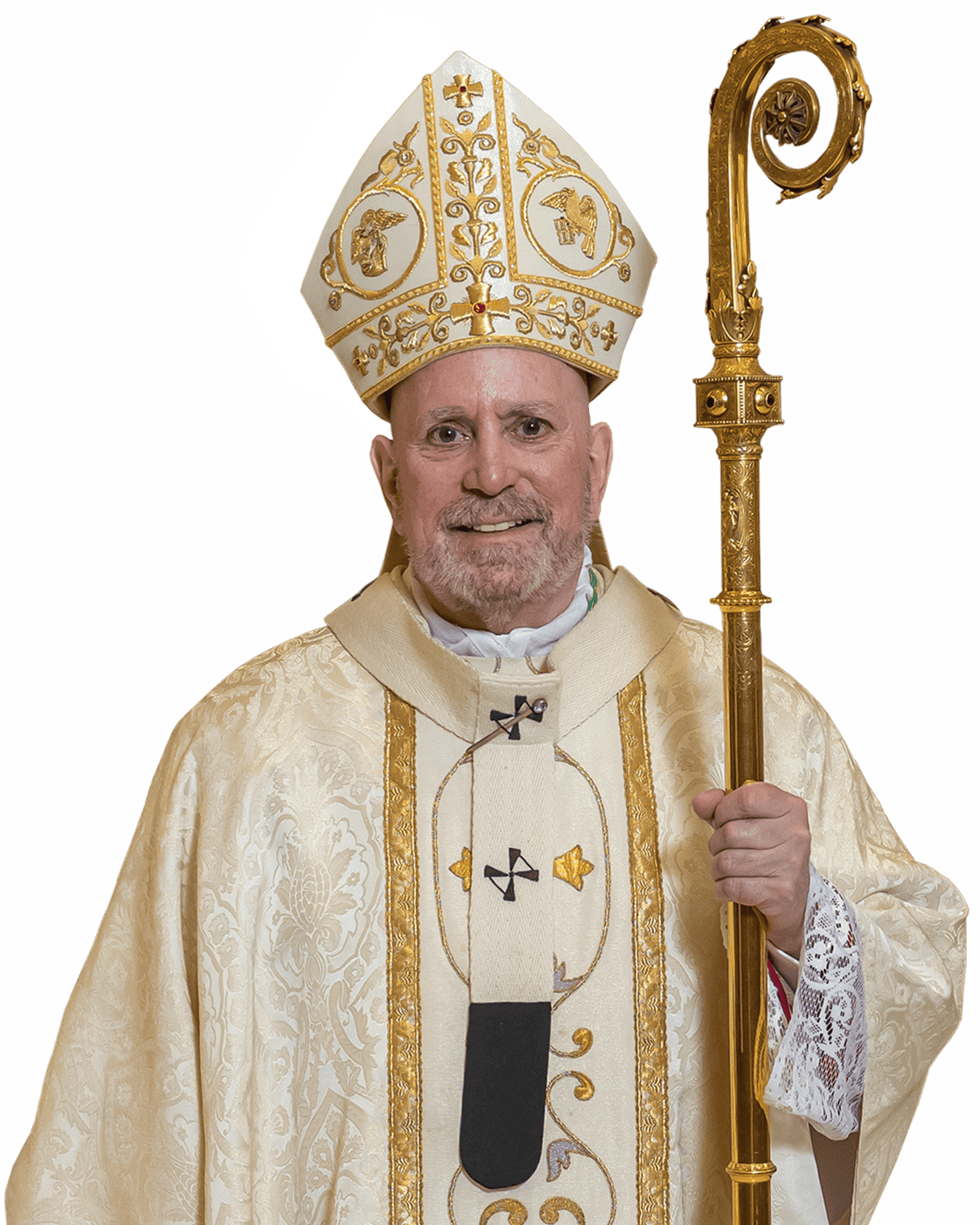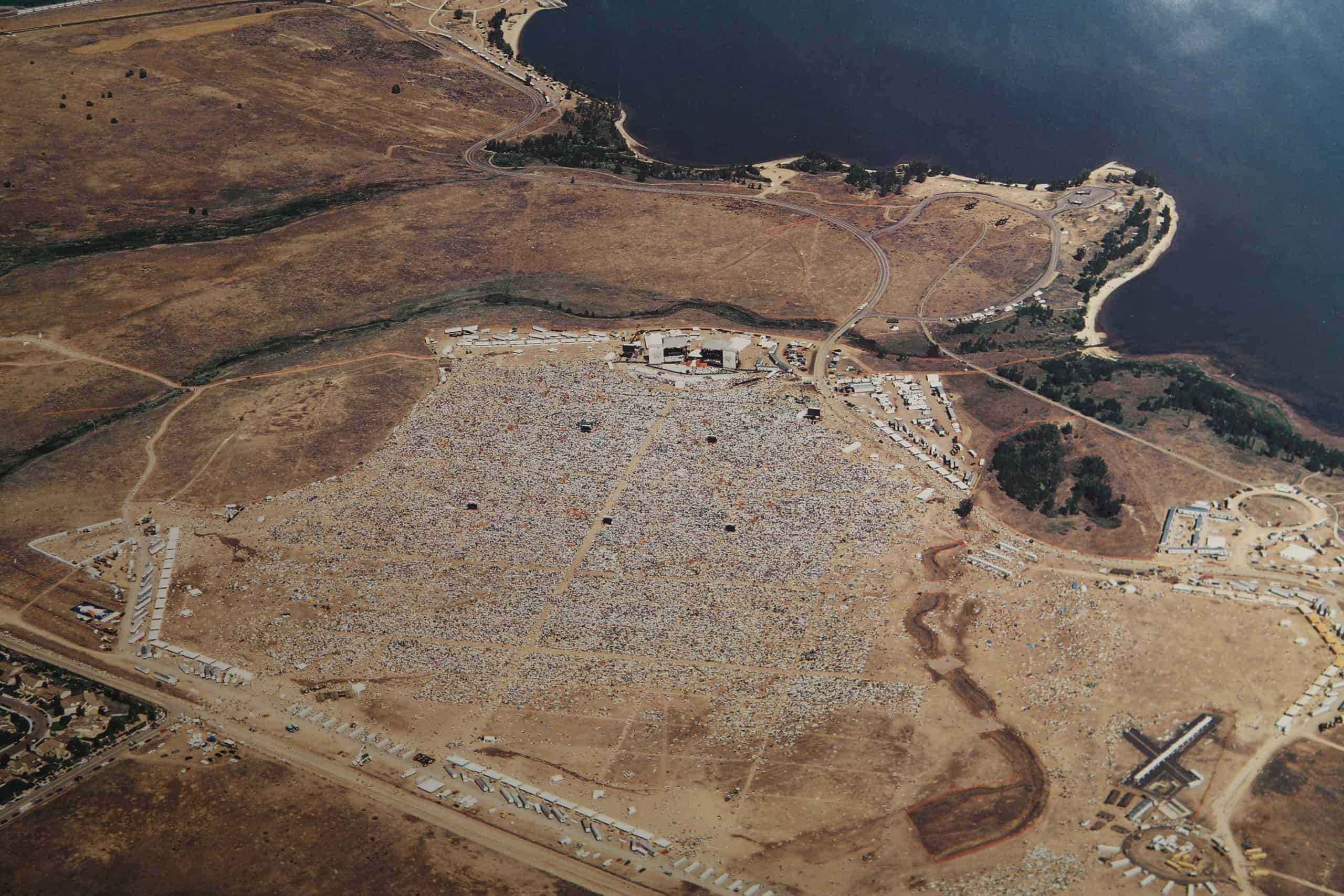September 2025 PASTORAL NOTE
"A Mission
Diocese Again"
How the Archdiocese of Denver has been retooled for evangelization under Archbishop Samuel J. Aquila, by Scott Elmer, D. Min. Chief Mission Officer, Archdiocese of Denver
When Archbishop Samuel J. Aquila returned to Denver in 2012, he stepped back into an archdiocese with a remarkable story. The city was still remembered worldwide for the electric moment of World Youth Day 1993, when Pope St. John Paul II drew hundreds of thousands to the Mile High City and set a new tone for Catholic life in the region. The years since had been marked by innovation, especially in the areas of priestly formation, the diocesan curia and lay apostolates.
But the cultural terrain since 1993 and especially since 2012 had changed. Like much of the West, Colorado had entered what we now recognize as a post-Christendom era, where the shared Christian assumptions that once shaped public life have faded. Increasingly, Catholics could no longer assume their neighbors knew the basics of the Gospel or saw the Church as a moral compass. In this reality, Archbishop Aquila spoke plainly: we are living in a new apostolic age, one more like the first century than the twentieth, and our parishes must learn to think and act like mission outposts in a mission field.
Over the last decade, Archbishop Aquila and his collaborators have worked intentionally to retool the Archdiocese of Denver, including its culture, structures, events and partnerships, so that mission is not just one priority among many, but the heartbeat of everything. In more recent years, that transformation was made visible in the More Than You Realize conference, the impact of ACTS XXIX and the Rescue Project, the launch of regional Mission Support Centers, the measurable growth in priestly and diaconal vocations, the robust embrace of the Synod on Synodality, the bold public witness of the National Eucharistic Revival and Pilgrimage, and the global reach of apostolates like FOCUS and (until recently) the Augustine Institute.
Crucially, this shift has been guided by a deliberate strategic framework: three Mission Anchors — Holy Priests, Equipped Leaders for Mission and Missional Curia — that answer a simple but defining question: How will we succeed in this new apostolic age?
A rallying cry for the new apostolic age: More Than You Realize
One catalytic moment in Denver’s missionary turn came on August 11, 2018, with the More Than You Realize (MTYR) conference. Timed to mark the 25th anniversary of WYD ’93, the day drew thousands to reflect not just on past graces but on the next quarter-century of Catholic life. The focus was clear: ordinary Catholics are called to live as missionary disciples, sharing the Gospel not just in church settings but in workplaces, neighborhoods and families. The Church, in turn, needed to be set up to support that mission.
The phrase “More Than You Realize” carried a profound double meaning. On one hand, it reminded Catholics that faith, mission and the Gospel have a far greater role in shaping modern life than most recognize. On the other, it proclaimed that in a time of cultural confusion and relativism, there is more truth, goodness and beauty in Jesus Christ than many imagine. In short, MTYR insisted that Catholic faith is not a private devotion; it is “more than you realize,” with a vital place in our post-Christendom, apostolic age.
The conference launched a discipleship initiative in the archdiocese built upon four pillars that posed four questions: How do we receive? How do we form? How do we free up? And how do we go out? Following the conference, the archdiocese organized training sessions for parishes to reevaluate their key touchpoints with both parishioners and non-parishioners and to create strategies for better receiving all who come to their doors. These questions also became the seedbed for future initiatives such as the Mission Support Centers, evangelization workshops and many more.
The most prominent aspect of the initiative provided high-quality, shareable content rooted in truth, beauty and goodness; it offered practical training for small-group leaders; and it gave Catholics tools to spark conversations that lead naturally to the deeper proclamation of the Gospel. Its pillars of beautiful content, practical formation and intentional relationships formed a bridge from the archdiocese’s past strengths into the missional posture required for the new apostolic era.
Amidst the storm, a missional vision emerges
Yet as this new wave of energy spread, a crisis shook the Church in the U.S. The fallout from the McCarrick scandal prompted dioceses nationwide, including all three dioceses in Colorado, to launch an Independent Review and Reconciliation (IRR) program for historic sexual abuse. This effort provided survivors with the chance for justice and healing, while helping ensure trust and transparency in the Church’s leadership.
As the findings of the IRR program were made public and its work concluded, anticipation of a brighter 2020 and “restart” of MTYR was on everyone’s minds. However, only a few months into the new year, COVID changed everything — especially the way the Church ministered to the faithful. With TV and YouTube Masses becoming more commonplace amidst lockdowns and Zoom meetings, Archbishop Aquila’s calendar suddenly opened for the first time in decades. The fruit of that unexpected availability was significantly more and richer prayer, which led to renewed missionary zeal for the archbishop and a refocus on what makes a thriving diocese.
Behind the scenes, the archbishop and archdiocesan staff read From Christendom to Apostolic Mission from the University of Mary Press, which poignantly describes the post-Christendom era. Convicted by the need to adjust to the new apostolic age, they began meeting with Acts XXIX, a Detroit-based apostolate focused on providing foundational guidance for a Church operating in a post-Christendom era. Father John Riccardo, Acts XXIX’s founder, published Rescued soon after, and both books became foundational to the work to come.
Archbishop Aquila then formed the Mission Leadership Team, a group of key mission-focused advisors, to continue this prayerful discernment on behalf of the Archdiocese and begin executing on what the Holy Spirit had shared. Initially, their prayerful discernment clarified why the Archdiocese of Denver exists at all, which is:
“…so that in Jesus Christ all might be rescued and have abundant life, for the glory of the Father.”
This team also discerned that major decisions in the Archdiocese should be directed by three Mission Anchors: Holy Priests, Equipped Leaders for Mission and a Missional Curia. Three Mission Values were also discerned, which provide the framework to engage and live out the mission on a personal level:
- Abide in Relationship: placing a primacy on growing in the love of God above all other things, which is charity.
- Be the Cavalry: Recognizing that, for the task before us, no cavalry is coming to take care of it. We need to step boldly into the mission and be the cavalry.
- Confound the World: joyfully witnessing to Christ in a way that surprises and unsettles a culture increasingly hostile to Catholic faith, especially in hubs like Denver and Boulder, long considered centers of pro-abortion activism.
Mission Anchor #1: Holy Priests
The first Mission Anchor recognizes a truth that has shaped every age of the Church: in times of challenge and change, the holiness of priests is decisive. Denver has invested deeply in priestly flourishing through initiatives like the Priest Flourishing Survey, convocation gatherings focused on healing and dedicated days of reflection such as Seven Thursdays for Christ.
A recent USCCB study revealed that priests across the U.S. often report poor relationships with their bishops. By contrast, Denver’s priest flourishing survey showed that most priests feel personally supported by Archbishop Aquila and trust in his leadership. This culture of fraternity and trust is bearing fruit: the class entering seminary in 2025 is the largest since St. John Vianney Theological Seminary reopened in the late 1990s. It is the largest number of men entering the seminary in one year over the past 50 years.
This vision of holistic priestly life has also shaped the Monsignor Glenn Recreation Center, now nearing completion on the seminary campus. The facility will provide seminarians with a place to grow in fraternity, balance and healthy habits that will sustain them throughout their priesthoods. It reflects Denver’s conviction that forming holy priests requires caring for body, mind and spirit, preparing men who can serve the mission with joy and resilience.
Mission Anchor #2: Equipped Leaders for Mission
The second anchor insists that mission requires multiplying leaders, both clergy and lay, who can bring Christ into every sector of society. At the heart of the anchor is the conviction that the archdiocese must prioritize pastoral, or apostolic, formation over the other areas (intellectual, human and spiritual). In Denver, this has taken form in evangelization workshops, parish mission pilots, the Institute of Apostolic Leadership and charism-based formation.
Through the Institute of Apostolic Leadership, a joint project between the Archdiocese and the Missio Institute, pastors are formed with their leadership teams to pray, think and lead in new ways suited for an apostolic age. So far, 10 parishes have experienced the year-long formation, and seven participate in an ongoing Apostolic Leadership Network.
Mission Anchor #3: Missional Curia
The third anchor orients the entire work of the curia to supporting and advancing the mission in all areas of the archdiocese. Necessarily, it reformed the archdiocesan offices themselves and the way staff are onboarded, so they operate as servants of mission, not obstacles to it. Silos have been broken down, a common mission is embraced, morale has increased and the joy of the Gospel is lived more fully. This shift has been embodied in practices like:
- A strongly encouraged 30 minutes of daily chapel prayer during work hours, not squeezed into a lunch break or tacked on after-hours.
- Annual staff retreats and formation experiences.
- A dedicated John 15 Team tasked with cultivating a missionary culture among staff.
- Mass for employees at least three days per week on campus, which has outgrown our old chapel, forcing a move into a larger space, and monthly Confession.
- Bringing Acts XXIX’s Rescue Project to employees, so all understand the kerygma, have a personal encounter with Jesus Christ and see their role in Jesus’ mission.
- An on-site health clinic for employees.
- A Day of Rest program, offering employees a day of prayerful retreat and renewal.
- Expanded maternity and paternity leave policies.
In tandem with the other anchors, the missional curia anchor has found expression in founding and strengthening apostolates that equip people for evangelization in their state in life.
- Marisol Health, connected to Catholic Charities, and Bella Health + Wellness provide life-affirming medical care for women and families. Their compassionate witness to the dignity of life is itself evangelization, showing the Gospel not as abstract principle but as concrete hope.
- The Colorado Catholic Conference equips leaders to bring the Gospel into public life by coordinating advocacy at the capitol. This ensures that Catholic voices are heard where laws and policies are shaped.
- Annunciation Heights, a youth and family camp opened in 2018, forms leaders in the making by fostering encounters with Christ in the beauty of creation, helping young people and families alike to integrate faith into daily life.
- Prophet Elijah House was built on the St John Paul II Campus to provide retirement living for our priest.
- The renewal of the Mullen Home through Mullen Residences, continuing the legacy of care for the elderly after the Little Sisters of the Poor departed, ensures that Catholic leadership includes the works of mercy, training laypeople and staff alike in leadership rooted in service and compassion.
- St. Gianna Molla and St. John Paul II parishes were opened in growing areas in a proactive response to demographic shifts in Colorado.
- Independent Catholic high schools like St. John Paul the Great, St. John Paul II, Chesterton Academy of Our Lady of Victory and Chesterton Academy of Our Lady Seat of Wisdom have also opened their doors with the blessing of the Archdiocese, serving Catholic students across Northern Colorado in new and growing areas.
- Additional parish and Catholic school sites are being evaluated in anticipation of growth, particularly as metro Denver continues to expand into rural areas.
- Grants funds have also been refocused from the Archbishop’s Catholic Appeal to seed and support new and upcoming initiatives to promote diversity and dynamism in the mission field.
Supporting all these anchors as well are the Mission Support Centers (MSCs), which take on administrative overhead at the parish and ministry level through regionally deployed specialists. By freeing clergy and lay leaders from burdensome administrative tasks, MSCs enable them to focus on equipping others and living out the front-line mission of evangelization.
The Missional Curia ensures that the Archdiocese’s internal life is itself a witness to the mission it serves. As with Equipped Leaders for Mission, Mission Support Centers are part of the Missional Curia anchor, bringing a missional focus from the Curia out into the field.
Catholic Schools: Mission at a Crossroads
Catholic schools have long been one of the Archdiocese of Denver’s most powerful opportunities for evangelization. They form young people not only in academic excellence but also in faith, virtue and missionary identity. For generations, they have often served as the “front door” through which families re-encounter the Church.
At the heart of our vision for Catholic education is the conviction that parents are the primary educators of their children. Our schools exist to unite the mission of the Church and the family, creating a “sanctuary of education” — a sacred place of transformative encounter with Jesus Christ where students grow in wisdom and virtue and discover God’s great calling for their lives.
Catholic schools are the largest ministry of the Archdiocese, second only to our parishes themselves. Their scope means that the way we steward, renew and reimagine Catholic education will significantly shape the missionary future of the Church in Northern Colorado.
Yet Colorado’s dramatic changing demographics present sobering challenges. Denver’s population trends show fewer school-aged children in many urban neighborhoods, while population growth is concentrated in suburban areas that are not always well served by existing Catholic schools. In recent years, public districts across the metro area have closed numerous schools due to declining enrollment, and Catholic schools feel similar pressures.
This moment calls for a rethinking of Catholic education in Denver, including its locations, finances, funding model and curriculum. The Archdiocese is actively discerning how to meet these challenges through:
- Location: evaluating where families live and are moving, and ensuring Catholic schools are available where they are most needed.
- Finances and funding model: exploring sustainable approaches to keep tuition accessible, while strengthening development and leaning into MSC for administrative and enrollment support.
- Curriculum: doubling down on distinctively Catholic identity, integrating evangelization and discipleship with academic excellence, so that every graduate is both well-formed and mission ready.
Catholic schools in Denver cannot simply rely on the cultural Catholicism of the past. In the new apostolic age, they must become intentional evangelizing communities — true sanctuaries of education where families encounter Christ, where children are formed in virtue and mission and where the partnership between parents and educators reflects the Church’s deepest vision of Catholic education.
A Hub for Global Evangelization
Finally, the fruit of these anchors is not limited to Colorado. Denver has become a launchpad for apostolates that embody the New Evangelization worldwide:
- FOCUS (Fellowship of Catholic University Students), which sends nearly 1,000 missionaries to campuses across the U.S. and abroad.
- Christ in the City, whose young missionaries encounter the homeless, bringing Christ to the streets while forming Catholics nationwide in works of mercy.
- Creatio, which evangelizes through outdoor adventure and pilgrimages that resonate deeply with younger generations and Colorado’s outdoor culture.
- The Lay Division of St. John Vianney Seminary, which equips thousands of lay Catholics globally with robust theological and scriptural formation.
- And until a recent move to St. Louis, the Augustine Institute, which offered graduate-level theology and evangelization degrees. The “AI” attracted students to Denver for in-person learning and drew a global student base through its online courses. They also created the FORMED platform, which has been compared to a “Catholic Netflix.”
Together with local ministries like Bella Health + Wellness, Annunciation Heights and the Colorado Catholic Conference, these apostolates illustrate how the three Mission Anchors (holy priests, equipped leaders and a missional Curia) work together to make Denver not just an archdiocese, but a missionary hub for the New Evangelization.
A public Church in the streets: Eucharistic Revival
In 2024, the National Eucharistic Pilgrimage’s St. Junípero Serra Route crossed Colorado, drawing thousands. Stops included Rangely, Steamboat Springs, Camp St. Malo’s Chapel on the Rock, Boulder’s St. Thomas Aquinas and numerous Denver-area parishes and institutions before heading to the Eastern Plains. On June 9, Archbishop Aquila led the largest Eucharistic procession in Denver’s history, with nearly 5,000 people walking down central corridors in the city in public witness to the Real Presence of Christ.
From Christendom to Apostolic Mission
Look closely, and a pattern emerges:
- Culture for mission: MTYR reignited Catholic imagination for evangelization.
- Structure for mission: MSCs empower parishes for front-line ministry.
- Leadership for mission: The Mission Anchors guide priests, leaders and structures.
- Events for mission: The Synod and Eucharistic Revival were moments of deep formation and bold witness.
- Institutions for mission: Seminaries, apostolates and lay programs provide lasting capacity.
In the post-Christendom reality, the Church cannot rely on cultural support but must rely on intentional discipleship and mission. Denver’s shift under Archbishop Aquila has been about facing that reality without fear, embracing the missionary identity of the Church and building the capacity to live it.
By holding fast to the three Mission Anchors and living these mission values, the Archdiocese of Denver is aligning vision, vocabulary and velocity. The result is a local Church both realistic about the challenges ahead and confident in the Lord who sends her.
The Most Rev. Samuel J. Aquila was installed as the Archbishop of Denver on July 18, 2012 at Denver’s Cathedral Basilica of the Immaculate Conception.
Archbishop Aquila’s episcopal motto is taken from the fifth version of the second chapter of the Gospel of St. John:
“Do whatever he tells you.”



